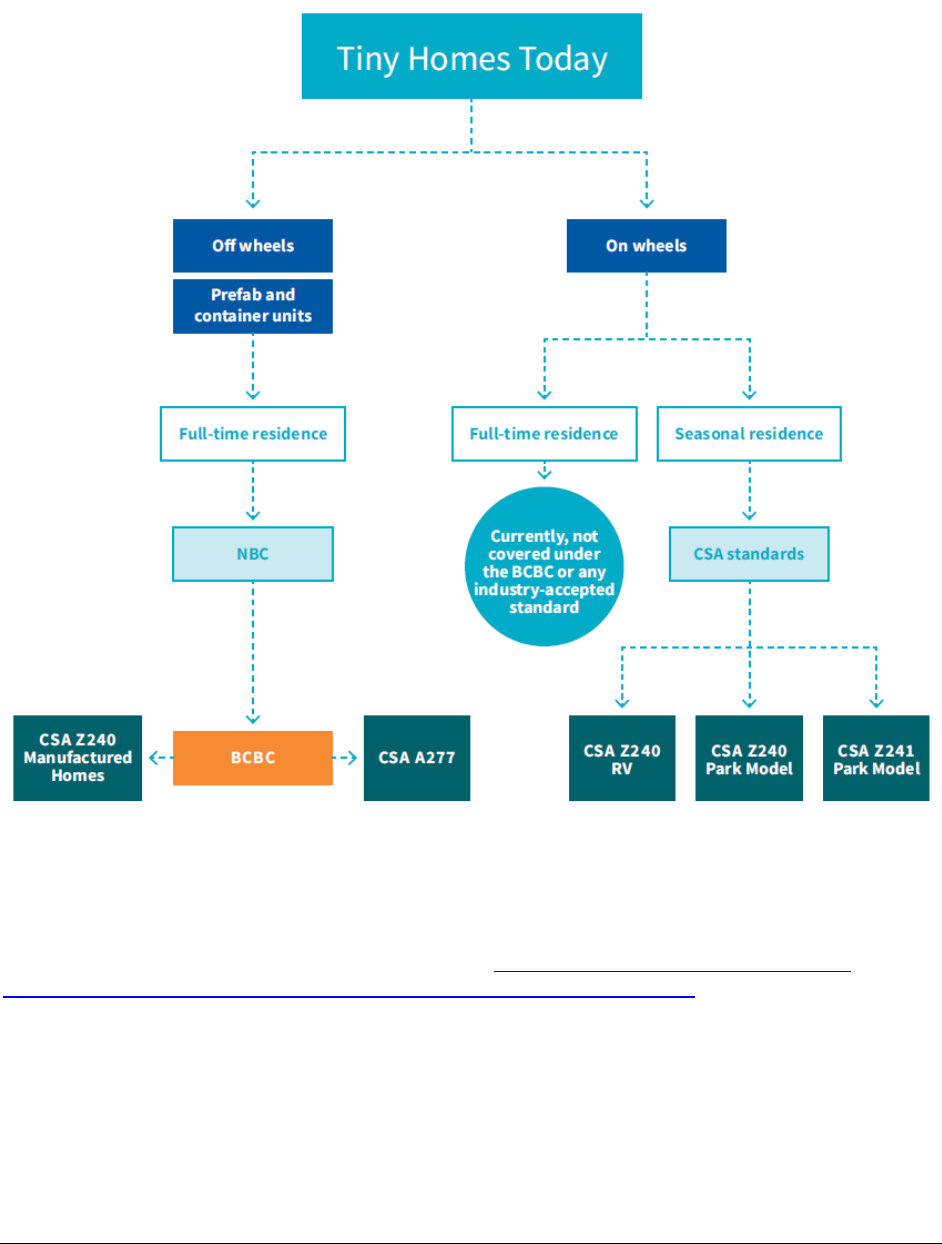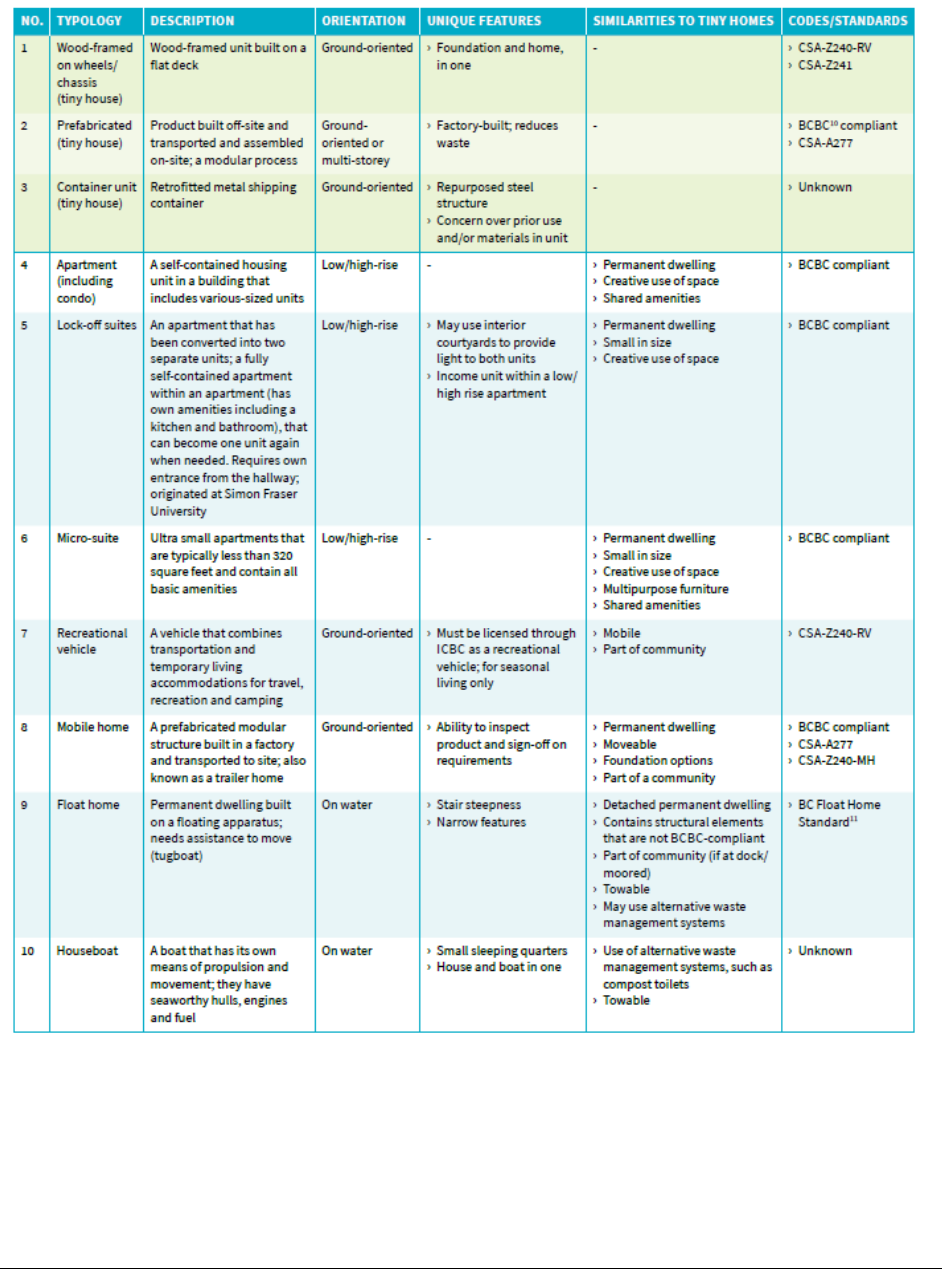
STAFF REPORT
STAFF REPORT Page 1 of 7
To: Chief Administrative Officer Date: July 5, 2021
From: Robert Publow
Subject: City of Kitchener Additional Dwelling Units (Tiny Homes) Bylaw
Recommendation(s)
This report is provided for information. No staff recommendation accompanies this report and
Council action is not required.
Summary
This report provides an overview of the recent bylaw amendments considered and approved by
the City of Kitchener, Ontario, to allow for Additional Dwelling Units (with specific reference to
Tiny Homes) and compares their approach to the City of Mission’s current approach for the
equivalent use called detached Secondary Dwelling Units within Mission. Some options for
amendments to the City of Mission bylaws that could follow the City of Kitchener example are
discussed along with a discussion of how tiny home uses would complement the need for
affordable housing in Mission.
Purpose
This report is to provide information in response to Resolution RC21/263 from the May 17, 2021
Regular Council Meeting.
RC21/263
That Staff review the City of Kitchener, Ontario model of integration of tiny homes and
provide a report to Council by July 5, 2021 with options on how tiny homes could fit
within the District of Mission.
Background
In response to changes to the Ontario Planning Act in 2019, many communities in Ontario are in
the process of enacting changes to their respective land use bylaws to allow for additional
dwelling units on single family and duplex lots.
The changes that were considered and approved in Kitchener effectively added a use called
Additional Dwelling Units (Detached) to the Kitchener Zoning Bylaw within all zones that permit
single family homes and or duplexes and limited the maximum number of dwellings on any one
lot to 3.
Additional Dwelling Units (Detached) are described in the Kitchener staff report as including:
o backyard home, coach house, laneway suite, tiny house, garden suite, etc.
Discussion and Analysis

STAFF REPORT Page 2 of 7
The constant and ever-increasing challenges to provide housing affordability and housing
availability has driven communities to consider many different approaches to fulfill this need for
more housing choices. One of the options to add housing options which are affordable and
generally accessible is through the allowance of secondary dwellings in addition to a principal
residence. In Mission, this has been provided as Secondary Dwelling Units (‘s’ Zones) as
defined by the City of Mission’s Zoning Bylaw.
The District of Mission Zoning Bylaw 5949-2020 permits Secondary Dwelling Unit uses in the
form of a Secondary Suite, Coach house, or Garden Cottage.
Within the City of Kitchener Zoning Bylaw, the term that is used is Additional Dwelling Units
(Detached). The City of Kitchener describes Additional Dwelling Units (Detached) as including
backyard home, coach house, laneway suite, tiny house, garden suite, etcetera.
Summary of the City of Kitchener’s approach
The amendment to the City of Kitchener Zoning Bylaw allowed Additional Dwelling Units
(Detached) on all residential lots that permit single family homes and or duplexes.
The City of Kitchener bylaw includes a list of minimum standards for the lot and the proposed
structure, which have been condensed and listed below:
1. A maximum size of dwelling - maximum floor area of 50% of the area of the main
dwelling or 80 square metres, whichever is less.
2. A minimum lot area of 395 sq m (4,250 sq ft) and a minimum lot width of 13.1 m (43 ft) is
required.
3. A requirement that the unit be connected to full municipal services.
4. A requirement for the Additional Dwelling Unit (Detached) to be setback a minimum of
0.6 m (2 ft) from the side and rear property lines, a maximum building height for most
roof types of 4.5 m (14.75 ft or 1.5 storeys), and a maximum lot coverage for all
accessory buildings of 15%.
5. Setback requirements for the main dwelling. For single detached dwellings and
duplexes, 1.2 m (4 ft) will be required on each side. For semi-detached dwellings 2.5 m
(8.2 ft) will be required on one side.
6. Only allowing the units in the rear yard, which mirrors current zoning rules for sheds and
detached garages.
7. A requirement for a 1.1 m (3.6 ft) walkway from the detached unit to the street.
8. For new Single Detached, Duplex, and Semi-Detached Dwellings that will have an
Additional Dwelling Unit (Detached), a requirement that its front yard setback must be in
line with the setback of neighbouring properties.
9. Requiring that 1 parking space per unit be provided on-site for the unit.
10. Allowing up to 3 parking spaces to be in tandem on a property (one behind the other).
It is important to note that the reference to “tiny house” within the City of Kitchener documents is
referring to structures that are constructed or approved under either the provincial building code
or Canadian Standards Association (CSA) Group standards, such as CSA A277, or CSA Z240
Manufactured Homes (MH). There is no option within the City of Kitchener Bylaw which would
allow the approval of a tiny house that is not CSA approved.
The current City of Mission approach

STAFF REPORT Page 3 of 7
The City of Mission Zoning Bylaw offers corresponding Secondary Dwelling allowances to all
single family residential zones; these zones are referred to as ‘s’ zones. Mission’s current
approach is to rezone properties at the request of property owners and are considered on a
case-by-case basis to ensure the appropriate ‘s’ zone is applied to allow a Secondary Dwelling
Unit, which can be constructed at the discretion of the owner as a Secondary Suite, Coach
House or Garden Cottage. For the purpose of this discussion, the focus will be on how detached
Secondary Dwellings (Coach Houses and Garden Cottages) are regulated in the City of
Mission.
In general, each application for a corresponding ‘s’ zone is reviewed against several basic
parameters:
Available lot area for the proposed type of Secondary Dwelling
Access to the proposed Secondary Dwelling
Availability of additional required parking
Availability of road frontage for overflow parking
Integration of Secondary Dwelling into the surrounding neighbourhood
The single most common source of concern and complaints related to any Secondary Dwelling
Unit is parking, and therefore the provision of parking receives a significant amount of scrutiny
during the review process.
The City’s Zoning Bylaw contains regulations on setbacks, maximum sizes, and heights for
detached Secondary Dwellings and are summarized below:
OCP designation
Rural
Rural
Residential
Suburban
Urban
Urban
Compact
Max size
110 sq m
(1,184 sq ft)
50% of
principal
dwelling
110 sq m
(1,184 sq ft)
50% of principal
dwelling
75 sq m
(807 sq ft)
50% of principal
dwelling
75 sq m
(807 sq ft)
50% of principal
dwelling
75 sq m
(807 sq ft)
50% of principal
dwelling
Height
9.0 m
(29.5 ft)
9.0 m
(29.5 ft)
S20s - 9.0 m
(29.5 ft)
S10s - 8.0 m
26.2 ft)
8.0 m
(26.2 ft)
No taller than
Principal
Dwelling
8.0 m
(26.2 ft)
No taller than
Principal
Dwelling
Permitted in front of
principal dwelling
Yes
Yes
No
No
No
Front setback
7.5 m (24.6 ft)
7.5 m (24.6 ft)
7.5 m (24.6 ft)
7.5 m (24.6 ft)
7.5 m (24.6 ft)
Rear setback
7.5 m (24.6 ft)
7.5 m (24.6 ft)
1.3 m (4.3 ft)
1.3 m (4.3 ft)
UC465s
1.2 m (3.9 ft)
UC372s
0.5 m (1.6 ft)
Interior side setback
4.5 m (14.8 ft)
3.0 m (9.8 ft)
1.5 m (4.9 ft)
1.5 m (4.9 ft)
1.2 m (3.9 ft)
Exterior setback
4.5 m (14.8 ft)
4.5 m (14.8 ft)
4.5 m (14.8 ft)
3.0 m (9.8 ft)
3.0 m (9.8 ft)
As mentioned, parking is often a concern related to detached Secondary Dwelling Units. The
current requirement is 2 parking stalls for the principal dwelling and 1 stall for the secondary

STAFF REPORT Page 4 of 7
dwelling, for a total of 3 parking stalls on a site. The provided parking stalls must provide
unencumbered access to the street.
Summary
The City of Mission Zoning Bylaw contains all the same basic regulations as was introduced into
the City of Kitchener Bylaw. The significant difference is that the City of Kitchener Bylaw
amendment made Additional Dwelling Units (Detached) an outright permitted use in all single
family and duplex zones, compared to the City of Mission’s approach which requires rezoning of
individual properties to specifically allow for a Secondary Dwelling Unit.
Another difference is parking. The City of Kitchener allows tandem parking of all 3 required
parking stalls, compared to Mission’s Bylaw which requires that each parking stall to have
access to the street without interfering with one of the other parking stalls. This requirement for
unencumbered parking does become challenging on smaller lots, especially where the
dwellings are situated close to the road or lane. The City of Mission’s approach allows detached
Secondary Dwelling units in areas without sanitary sewer service where in the City of Kitchener
the lot must have full municipal servicing.
Options for amendments to the City of Mission approach
The most straightforward way to integrate the City of Kitchener example would be to allow
detached Secondary Dwellings in all Urban, Urban Compact and Suburban zones where
sanitary sewer and municipal water is available. If this option is considered for the urban area, it
should also be considered whether to include those Rural and Rural Residential areas where
sanitary sewer and water service are not available. It is noted that this option is being carefully
considered in Mission’s Secondary Suite program.
As noted, the City of Mission’s parking requirements are more onerous than those of the City of
Kitchener. Changes to the parking requirements should be carefully considered to ensure that
impacts to residential neighbourhoods are minimized.
Another option that could be considered would be to permit more than 1 detached secondary
dwelling on a lot under certain conditions, such as minimum lot area per dwelling and available
parking.
If there are changes made to the zoning bylaw to allow Secondary Dwelling as outright
permitted uses a potential concern might be a shift in workload from the Planning Division to the
Building Division.
Tiny Homes – What are they and how to they fit within the available options for affordable
housing
The City of Mission’s Zoning Bylaw does not have a minimum size requirement for secondary
dwelling units. Small, or tiny, detached Secondary Dwelling Units are currently permitted within
an ‘s’ zoned property and are restricted in maximum size. Detached Secondary Dwellings in
Mission are routinely designed at the maximum permitted, and significantly smaller units are the
exception.
There are several recognized standards created by the CSA Group which are used to describe
and regulate structures typically constructed in off-site factories. The City of Mission would
accept applications for Secondary Dwelling that meet the current BC Building Code, the CSA
A277 standard or the CSA Z240 Manufactured Home standard.
An excellent discussion regarding tiny homes and the current challenges related to municipal
approvals can be found in a report prepared by the BC Housing Research Centre titled Tiny
Homes – An Alternative to Conventional Housing.

STAFF REPORT Page 5 of 7
The diagram below, Figure 1, from the BC Housing report summarizes the current approval
options for the group of structures generically called tiny homes.
Figure 1
Generally, when the term ‘tiny home’ is used, most people think of small units typically
constructed on wheeled frames, that share more similarities to recreational vehicles than
permanent dwellings. But the truth is that there are many other types of dwellings, both
permanent and recreational that fall into to the broad discussion of tiny homes as depicted in the
table below, Table 1, from the report prepared by the BC Housing Research Centre titled Tiny
Homes – An Alternative to Conventional Housing (https://www.bchousing.org/research-
centre/library/housing-forms-designs/tiny-homes&sortType=sortByDate)

STAFF REPORT Page 6 of 7
Table 1
As demonstrated by the figure and table above, the first question that must be answered when
discussing tiny homes is what housing type is being discussed. In some contexts, such as that
of the City of Kitchener example, the term tiny house is the same as a Garden Cottage in the
City of Mission terminology. In many other situations, individuals are exploring the options for
placing a structure that is currently not approvable as a permanent residence in Canada as it

STAFF REPORT Page 7 of 7
does not meet the provincial building code, the correct CSA standard, or any CSA standard at
all.
Generally, tiny homes offer one option in the housing continuum to meeting affordability
objectives of a community. While there are differences in terminology and allowances for these
types of housing units from one community to the next, Mission continues to offer options for
secondary dwellings in it “s” zones and is currently working to make these housing options even
more accessible while at the same ensuring the best fit within neighbourhoods and providing
housing that meets life safety and building structure requirements as set out in provincial
regulations.
Financial Implications
There are no financial implications associated with this report.
Communication
No communication action is required.
Summary and Conclusion
This report provided a cursory comparison of the City of Kitchener example of integrating
detached Secondary Dwellings into their existing residential zones and preseted options for
future discussion on how those changes could be applied to the City of Mission including
possibilities where, and how many Secondary Dwellings could be permitted under different
situations.
The idea of tiny homes, what they are and how they can be approved as permanent residents
was also discussed.
This report is provided for information. No staff recommendation accompanies this report and
Council action is not required.
Report Prepared by: Robert Publow, Manager of Planning
Reviewed by: Monica Stuart, Planning Assistant
Approved for Inclusion: Mike Younie, Chief Administrative Officer
